Hello and welcome to ‘Focused on Feld’. In my Focused on Feld series of reviews, I am working my way through Stefan Feld’s entire catalogue. Over the years, I have hunted down and collected every title he has ever put out. Needless to say, I’m a fan of his work. I’m such a fan, in fact, that when I noticed there were no active Stefan Feld fan groups on Facebook, I created one of my own.
Today we’re going to talk about 2016’s The Oracle of Delphi, his 24th game.
2016 was a big year for Stefan Feld with the release of 3 different titles — The Castles of Burgundy: The Card Game, Jórvik, and this one. Out of those 3, The Oracle of Delphi was the only one that wasn’t a reimplementation of his earlier work. As of this writing, it still stands out as Feld’s first, and only, racing game. Whereas all of Feld’s other titles are won by the person with the most victory points or money, The Oracle of Delphi is won by the first person to reach the finish line.
Overview
In The Oracle of Delphi (OoD), Zeus has set out 12 different tasks for you to complete and you are racing to be the first person to accomplish all twelve. There will always be 3 specific colored monsters to defeat, 3 statues to erect at the randomly arranged building sites, 3 offerings to be delivered to specific colored temples, and 3 shrines to be erected on islands matching your player color.
Before starting the game, you will get 3 dice that have six different symbols (colors) on their faces and these dice will dictate which colors you will have at your disposal to carry out actions on your turn; actions such as moving your ship, collecting an offering from an island, or fighting a monster. Along the way, the players will receive assistance from the gods in the form of helpful, one-shot rule breaking abilities and will also receive favor tokens that will allow them to alter their dice results if they come up unfavorably. The first person to accomplish all 12 of their tasks and return to Zeus will win the game.
Of course this is an oversimplification. If you’d like to get more in depth about the game’s nuances, click on the bar below.
Preparing for the Voyage
The setup for a game of OoD is a little convoluted, so I’ll try to be as succinct as possible. First, you’ll create a playing area of water and island spaces by arranging the 12 board tiles. The rule book suggests several arrangements and recommends that you try to evenly distribute different objective types, but you can pretty much arrange the tiles any way you like. Evenly distributing objective types keeps different things (monsters, for instance) from being all clustered together at one end of the map. Randomizing the tiles instead of following the setups in the rules can upset this balance or create very difficult to overcome situations and should be saved for when you’re already experienced with the game.

Once you’ve arranged the board tiles, it’s time to populate them. Each city tile receives 3 statues of the depicted type. The six temples are placed on their respective temple islands. Then take as many offering cubes of each type and monsters of each type as there are players and evenly distribute them about the playing area in their respective locations such that no space contains pieces of the same color. Next, the island tiles are shuffled and placed face down onto the island spaces. Finally, the Zeus standee is placed in the center area of the circular tile containing 6 water spaces.
After setting up and populating the board tiles, set up the general supply. Shuffle the oracle cards and injury cards into face down decks. The companion cards are placed into a face up stack. Their order is irrelevant, but it makes it easier during the game if they’re at least sorted by color. Next, the equipment cards are shuffled into a face down pile and 6 of them are flipped face up next to the stack. The favor tokens are kept in a supply close by along with the battle die.
Now each player chooses a color and receives a player board along with 1 ship tile (either drafted or assigned randomly), 1 shield, 1 god token of each color, 3 shrines, 3 oracle dice, an action overview card, and the 12 Zeus tiles of their chosen color. The shrines are placed into their corresponding spaces along the top of the player boards. The shield is placed onto the 0 space. The god tokens are placed at the bottoms of their respective columns beneath the iconography that depicts the god’s action. The ship tile is placed onto the ship. Some of these ship tiles may adjust the starting positions of certain things, so adjust those things appropriately.
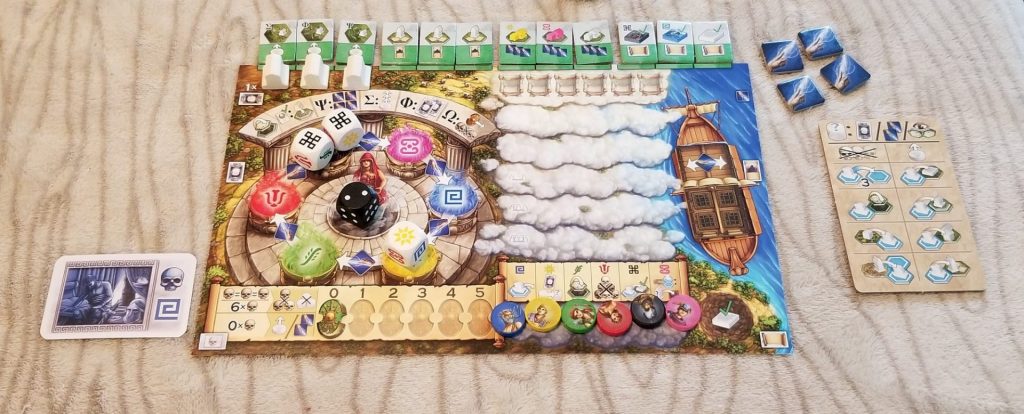
Next, each player rolls their oracle dice and places them onto their spots on the oracle circle. Each player will receive a randomly drawn injury card along with a number of favor tokens determined by player order. Whichever player is last in turn order will place the titan die in the center of their oracle circle. Finally, it’s time to arrange the Zeus tiles, which represent various objectives. Four of these depict different colored offerings on one side and monsters on the other. One player chooses 2 to flip to the monster side and 2 to keep on the offering side. Then all of the other players arrange theirs so that everyone winds up with the same objectives. These and all of the other Zeus tiles are placed into their locations along the top of the player boards and you’re finally ready to begin playing.
Setting Sail
OoD is played over a variable number of rounds that are broken down into several distinct steps:
- Check your injury cards: if you have acquired either 6 total injury cards or 3 injury cards of the same color, then you must discard 3 injury cards of your choice and forfeit your turn. If you have no injury cards, then you can either receive a favor token or advance a god token by one step (this will be covered later). If you have injury cards but not enough to force a discard, then nothing happens.
- Perform actions: use all 3 of your oracle dice and up to 1 oracle card to perform one of the available actions per each die or card used. We’ll get into more detail about the various actions shortly. Each die used is added to the middle of the oracle circle to show that it has been used and used oracle cards are discarded. Any number of god abilities can be used during this step as well.
- Consult the Oracle: roll your dice and announce the colors. If any player besides the active player has a god (that is not on the lowest rung of its column) matching any of the colors, then they may advance one of the matching colored gods by a single step.
Once all players have taken their turns, the last player rolls the titan die. If the die rolls a six, every player receives 2 injury cards. Otherwise the players consult their shield values. Any player with a shield value lower than the number rolled receives a single injury card. Then a new round begins.
Questing
Zeus has set out a series of 12 tasks that he wants the players to complete. He wants each player to construct 3 shrines, collect and erect 3 different statues at three different sites, collect different colored offerings and deliver them to their respective temples, and defeat 3 different colored monsters. If you’re the first player to complete these quests and return to him, you’ll gain his favor and win the game.
Achieving these goals isn’t going to be easy, though. Each round you’re only going to have 3 oracle dice to work with (and possibly some oracle cards), so you’ve got to make them count. Each die can be used to perform one of several functions:
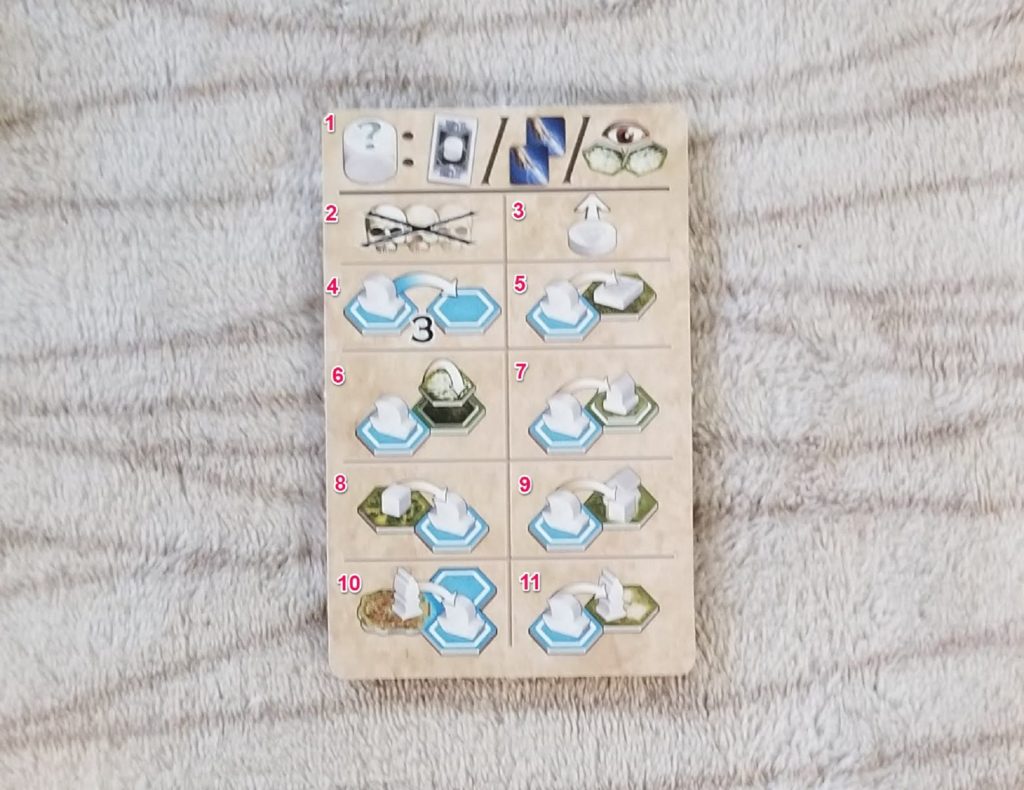
1. Discard a die to either draw an oracle card from the deck, take 2 favor tokens, or secretly peek at 2 face down island tiles and then replace them.
2. Discard a die to discard all injury cards matching the color of the discarded die.
3. Discard a die and advance the god of the matching color 1 space.
4. Discard a die to move a total of 3 spaces in the water. The target space must match the color of the discarded die. The player can spend favor tokens to extend the distance traveled by one space per token. However, the space the player ends their movement on must still match the color of the spent die.
5. Discard a die to fight a monster on a neighboring island. The color of the monster fought must match the color of the discarded die. Each monster begins the fight with a strength of 9 minus the value of your shield strength. To fight a monster:
- Roll the 10-sided battle die.
- If the number rolled is equal to or higher than the monster’s current strength, you win the fight, collect the monster tile, and discard the matching Zeus tile.
- If the number rolled is less than the monster’s current strength, you have lost. If the number rolled was a zero, you collect an injury card. You may pay a favor tile to reduce the monster’s strength by one and then fight it again. You can stop at any time without any further penalties.

6. Discard a die to flip the neighboring island tile to its face up side. The selected island tile must match the color of the discarded die. If the revealed image matches one of your Zeus tiles, then place one of your shrines on the tile, discard the Zeus tile, and collect the reward shown on the discarded tile. If the image does not match one of your Zeus tiles, then collect a reward based on the revealed Greek letter (4 favor tokens, 2 oracle cards, advancing gods several steps, or discarding all injury cards of a single color and increasing shield strength by one).
7. Discard a die to build a shrine. The discarded die must match the color of the island space and the shrine must be of your player color. Then you receive the reward on the Zeus tile and discard it.

8. Discard a die to load an offering from a neighboring island. The discarded die must match the color of the loaded offering and there must be enough room in the ship’s hold to accommodate the offering cube. By default, each ship can only hold two items in its hold.
9. Discard a die to make an offering to a temple on an adjacent island. The discarded die must match the color of the offering being removed from your ship’s hold and that offering must match the color of the temple. Then you receive the reward from the matching Zeus tile that is discarded. Players may never make the same colored offering more than once per game.
10. Discard a card to load a statue from an adjacent island into the ship’s hold. The discarded die must match the color of the statue.
11. Discard a card to erect a statue on a neighboring statue island. The discarded die must match the color of the statue and the statue must match one of the three colors depicted on the island. Then receive the reward from the Zeus tile and discard it. Players may never erect the same colored statue more than once per game.

Oracle cards can be discarded and treated as a die matching the color of the card. Only one oracle card can be used per round, though, so choose wisely. Oracle cards are also the first tie-breaker criteria at the end of the game.
The Rewards
As each quest is completed and the matching Zeus tile is removed, the players will receive various rewards. Here are the rewards:
- Building a shrine allows you to advance any of the gods by a single step.
- Erecting a statue rewards you with a companion card matching the color of the statue that was erected.

- Making an offering at a temple rewards you with 3 favor tokens.
- Defeating a monster rewards you with any one of the equipment cards from the display. This is then replaced with a newly drawn one. These cards provide game altering effects such as increased movement range, the ability to move your ship over gaps, or the ability to deliver statues and offerings without having to be directly next to the appropriate tiles.
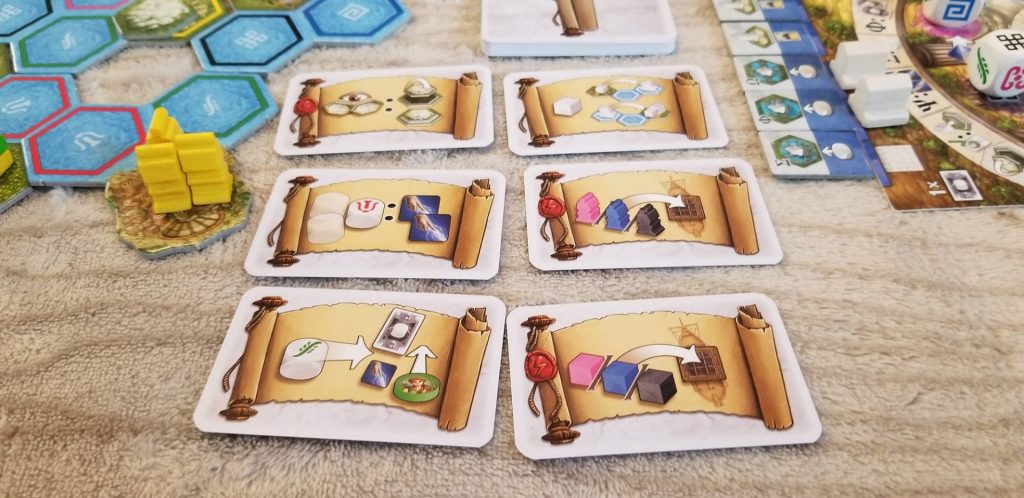
The Power of the Gods
As touched on earlier, each of the gods provide the player with a special ability once they have moved up their respective columns and reached their thrones. Once a god has been used for its ability, its token is moved back to the bottom of the column. The gods and their respective powers are:
Poseidon: Move your ship to any water space on the board.
Apollon: Draw an oracle card. Additionally, for this turn only, you can treat your oracle card and dice as if they were any color of your choice.
Artemis: Uncover an island tile and take the corresponding reward.
Aphrodite: Discard all of your injury cards.
Ares: Defeat a monster on an adjacent island without rolling the battle die, claim the reward, and discard the Zeus tile.
Hermes: If your ship is adjacent to a city tile, take a statue from any city tile of your choice and put it into your ship’s hold.
Or a player can opt to move the god token to the bottom rung of its column and draw an oracle card instead without using the god’s ability.
Thoughts
If you’re a hard core Stefan Feld fan like me, then it may come as some shock to you to learn that The Oracle of Delphi is my favorite Feld game. Stefan Feld has produced a lot of instantly recognizable titles that have enjoyed a lot more fame than this game has (The Castles of Burgundy and Carpe Diem are good examples) and The Oracle of Delphi is oft overlooked in his impressive dossier. Feld is well known for producing ‘point salad’ games and OoD is well outside of that mold. I think that’s one of the big reasons that it sits at the top of my list of Favorite Felds. There’s a level of intensity and edge-of-your-seat anticipation present in OoD that you just don’t find in any of his other games.
My fascination with The Oracle of Delphi surprises me, personally, because I typically abhor games that feature a lot of random, luck driven elements. And, believe me, OoD is one of those games. From the randomized setup to the hidden island elements to the die rolls, there’s almost nothing about this game that isn’t luck based. But that never really seems to matter all that much because Feld provides you with a plethora of options to choose from. So, there’s not a single moment in the game where you aren’t able to do something useful. Even if a die isn’t the color you hoped it would be, you can trade it in for favor tiles or to gain intel about the hidden island tiles.
All of those options, though, can sometimes make the game feel pretty frustrating. As you begin whittling down the tasks, the leftover tasks provide a lot of direction: go after the red monster, pick up the pink cube, etcetera. At the beginning of the game when you’ve got 12 unfulfilled tasks and your boat hasn’t moved a single hex, though, your options are very open and there’s nothing to inform you about which move is the strongest. It can feel a bit overwhelming trying to decide what to do first. It can also feel pretty crushing when you’re gunning for a specific objective and one of your opponents, gunning for the same thing, beats you to it. Worse yet, when you’re struggling to complete even a single objective and your opponents have already knocked out 3 or 4 of them, that can be a pretty miserable spot to find yourself in.
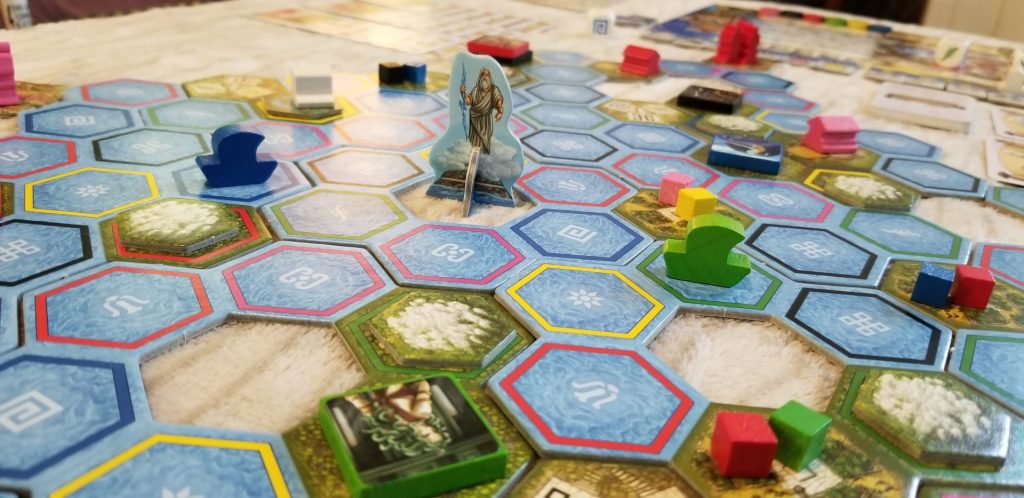
These kinds of scenarios are pretty typical in your first few games, but repeated plays will resolve this. As you become more familiar with the mechanics, you can begin thinking more about the strategy. You’ll begin to view the board differently, looking for clusters of objectives instead of just seeing a lot of disparate islands. “That water space over there borders a pink city tile and also a statue island with a pink symbol on it. And two water spaces from that is the green cube I need and that island borders another island with a monster on it…”
OoD is a game that rewards multiple plays. The more you play, the less afraid you’ll become to do things that may not have seemed very important in earlier games and your game will improve because of it. For instance, when I first began playing OoD, I was always reluctant to flip over an island tile without knowing what was on the other side lest I accidentally revealed one that belonged to my opponent. But those island reveal bonuses can have enormous impact on your game and you could get lucky and flip over one of your own. I was also loath to spend a die to move a god up a level. It wasn’t until I fully understood that in order for a god to move due to my opponents consulting the oracle at the end of their turns, it couldn’t be on the bottom rung, that I began actively incorporating that into my strategy.
Oracle of Delphi is a game that rewards clever plays. It’s one of those games that will occasionally present the player with the opportunity to pull off some wicked cool combos. It makes you feel like a bit of a badass when you’re able to knock out 3 or 4 tasks in a single round. This happens often enough that it’s more than a fluke. This ability to chain things together to produce amazing results is baked into the fabric of the game.
Not everything is perfect about OoD, though. It can suffer from a runaway leader problem at times, especially when one person has managed to get out ahead of everyone else by 4 or 5 objectives. When that happens it can feel pretty hopeless. It’s like getting lapped in a race, which is an appropriate comparison since that is exactly what OoD is: a race to the finish. Unlike the Laff-A-Lympics, though, there isn’t a way to sabotage the person that’s pulled into the lead and I really wish there were. If there was a way for the people in the back of the pack to hamper the person in the lead, The Oracle of Delphi would be perfect. As it sits, it’s only mostly perfect, and that’s good enough for me.
I love this game and I’ll gladly play it anytime, anywhere. You can play it anytime, anywhere, too: it’s free to play on Yucata and I highly recommend you go give it a try!


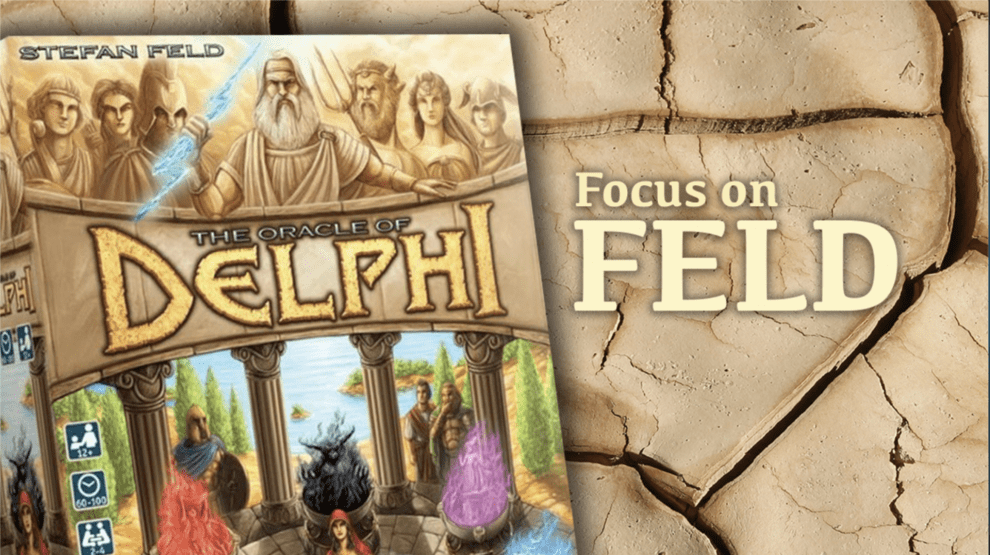


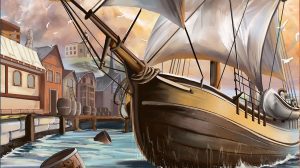





Add Comment